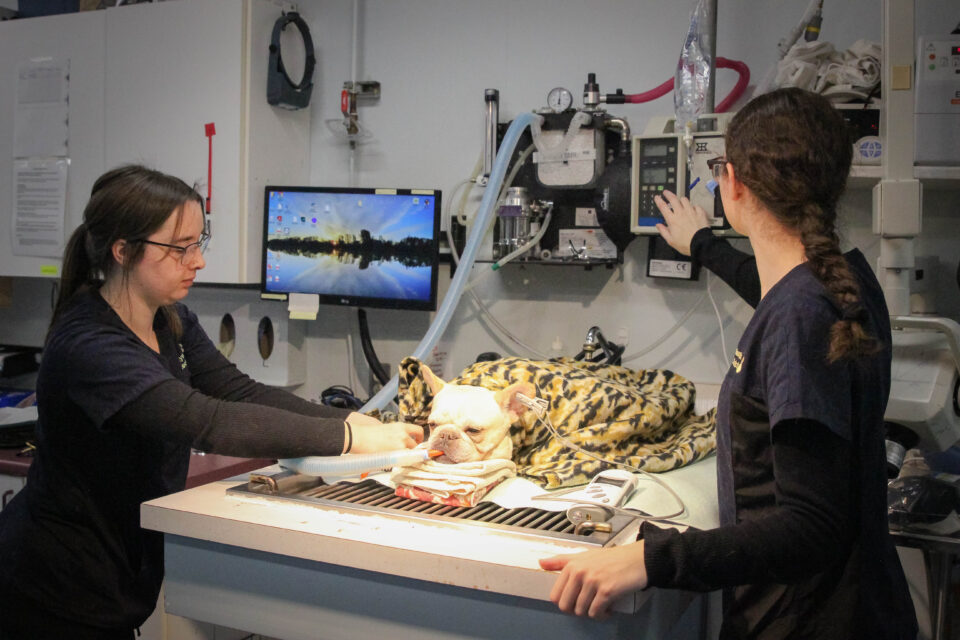Dental Care

One of the most common diseases in pets is “periodontal disease” or tooth disease. As health care and nutrition for pets have improved, our furry friends are living longer. As they age, they are more at risk for developing problems with their teeth.
Periodontal Disease
Unlike humans, our pets rarely develop “cavities”. Tooth disease in pets frequently follows the same steps:
- When pets eat, a film of food particles and bacteria is left in their mouth (this process is the same in humans). This film is called plaque and is generally invisible. Brushing can easily remove plaque, but many pets do not have their teeth brushed regularly.
- All pets have calcium in their saliva naturally. This calcium binds with the plaque on the teeth and hardens into tartar, a yellow or brown substance that is cemented to the tooth surface. Prolonged brushing can remove some tartar, but it is usually not very effective. At this point a professional dental cleaning is recommended.
- Tartar along the gum line of the teeth begins to push the gum away from the tooth surface. This causes the gums to become red, swollen and painful. This condition is called gingivitis and may cause some pets to stop chewing well, or in severe cases, to stop eating entirely.
- Bacteria in the mouth travel down to the root of the teeth through the opening created when the gum is pushed away from the tooth surface. These bacteria can cause infection at the root of the tooth, resulting in the tooth becoming loose or even dying as the infection attacks the blood supply to the tooth.
- As periodontal disease progresses, bacteria at the root of the tooth can get into the blood stream of the pet and travel around the body, causing infections in other organ systems. Periodontal disease may be associated with such conditions as heart, kidney and liver disease as these changes continue. Some studies show that all dogs over 5 years of age and 95% of cats over 8 years of age suffer from periodontal disease.
**Plan to have images associated with each stage of disease
Home Care
There are a number of things you can do at home to help prevent periodontal disease in your pet.
Brushing
The very best way to care for your pet’s teeth is also the very best way to care for your own teeth…brush them! Brushing your pet’s teeth just once a day can remove plaque and reduce the chance of tartar formation. Some pets are more tolerant of this process than others, but most pets can learn to accept brushing if it is introduced slowly. If you are interested in learning to brush your pet’s teeth, please make an appointment with one of our trained Technicians and Assistants.
Later – have a link to our own youtube video on this
Rinses
For pets who are truly resistant to brushing, there are oral gels and rinses which can be effective at reducing bacterial numbers in the mouth. Less bacteria = less plaque = less tartar = less periodontal disease. Some gels are also effective at reducing inflammation in sore gums as well. Please ask us if a gel or rinse is right for your pet.
Food
What could be easier than putting a toothbrush in your pet’s bowl every day? There are several veterinary exclusive dental diets available which have been proven to reduce both tartar and plaque on pet’s teeth. Transitioning your puppy to a dental formula when they become an adult can help protect their teeth from periodontal disease throughout their whole life. We can help you determine if a dental formula food is right for your pet.
Chews
Dental chews are often the first choice of pet owners for tackling dental care at home. Although some chews are proven to be effective at reducing tartar on pet’s teeth, there are a number of factors to consider when selecting the right chew. Some pets can experience intestinal upset (diarrhea) with too many chews, and often dental chews are high in calories, which can contribute to obesity. Chews should always be used in moderation. If you would like more information on choosing the right chew for your pet, we are happy to help!


